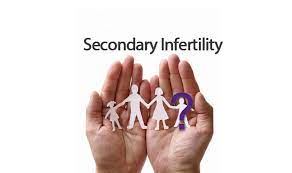Secondary Infertility
Secondary infertility is a topic that’s often shrouded in misconceptions and silence. Couples who have successfully conceived and given birth to a child but struggle to conceive again face unique challenges. In this comprehensive guide, we will shed light on secondary infertility, providing a deep understanding of this often misunderstood condition. Whether you’re personally experiencing it or seeking to support someone on this journey, we’re here to offer knowledge and hope.
Exploring the Causes of Secondary Infertility

secondary infertility
The Complexity of Secondary Infertility:
Secondary infertility is a complex and emotionally challenging issue that affects countless couples worldwide. To understand it better, let’s delve into some of the common factors that may contribute to secondary infertility:
Changes in Reproductive Health:
changes in reproductive health, reproductive system alterations, fertility challenges
Sometimes, changes in reproductive health can occur after giving birth. Conditions like polycystic ovary syndrome (PCOS), endometriosis, or uterine fibroids may develop or worsen, affecting fertility.
Age-Related Factors:
age-related fertility decline, maternal age impact, male fertility with age
Both female and male partners experience age-related changes that can affect fertility. As individuals age, the quality and quantity of eggs and sperm may decline.
Lifestyle and Habits:
lifestyle factors and fertility, smoking and infertility, alcohol consumption
Unhealthy lifestyle choices, such as smoking, excessive alcohol consumption, or obesity, can hurt fertility.
Previous Medical History:
previous pregnancies, postpartum complications, infections
Complications during previous pregnancies, postpartum infections, or surgical procedures can sometimes leave lasting effects on fertility.
Recognizing the Symptoms of Secondary Infertility
Symptoms to Be Aware Of:
Understanding the signs and symptoms of secondary infertility is crucial for timely intervention. Here are some key indicators:
Irregular Menstrual Cycles:
irregular periods, menstrual cycle changes, fertility signs
Irregular periods or drastic changes in menstrual cycles could be an early sign of secondary infertility.
Pain or Discomfort:
pelvic pain, discomfort during intercourse, fertility discomfort
Experiencing pain or discomfort during intercourse or in the pelvic area may signal an underlying issue.
Changes in Menstrual Flow:
heavy periods, changes in menstrual flow, fertility indicators
Noticeable changes in the flow of menstrual periods may indicate hormonal imbalances or other factors affecting fertility.
Medical Evaluation and Diagnosis
Understanding the Diagnostic Process:
If you suspect that you or your partner may be experiencing secondary infertility, seeking answers through a medical evaluation is the crucial next step. Here’s what to expect during the diagnostic process:
Consultation with a Specialist:
fertility specialist, reproductive health expert, secondary infertility diagnosis
Begin by scheduling a consultation with a fertility specialist or reproductive health expert. They will discuss your medical history and potential factors contributing to secondary infertility.
Fertility Tests:
fertility testing, diagnostic procedures, reproductive health assessment
Various fertility tests, including hormonal assessments, ultrasounds, and semen analysis for both partners, may be conducted to pinpoint any underlying issues.
Medical History Review:
medical history assessment, pregnancy history, postpartum complications
Your doctor will thoroughly review your medical history, including past pregnancies, postpartum complications, and any infections or surgeries.
Imaging and Procedures:
imaging tests, hysterosalpingography, laparoscopy, fertility procedures
Depending on initial findings, your doctor may recommend imaging tests like hysterosalpingography or more advanced procedures like laparoscopy to investigate further.
Treating Secondary Infertility
Exploring Treatment Options:
The good news is that there are various treatment options available for couples facing secondary infertility. The choice of treatment will depend on the underlying causes identified during the diagnostic process.
Lifestyle Changes:
lifestyle modifications, fertility-boosting habits, healthy living
In some cases, adopting a healthier lifestyle through diet and exercise can improve fertility.
Medications:
fertility medications, hormonal therapy, ovulation-stimulating drugs
Your doctor may prescribe medications to address hormonal imbalances or stimulate ovulation.
Assisted Reproductive Technologies (ART):
IVF (In Vitro Fertilization), IUI (Intrauterine Insemination), ART procedures
ART procedures like IVF and IUI offer advanced fertility options for couples with specific
Surgery:
fertility surgery, corrective procedures, reproductive surgery
Surgical interventions may be necessary to correct anatomical issues that are hindering fertility.
Emotional and Psychological Impact
Secondary infertility can take a toll on the emotional well-being of couples. It’s important to acknowledge and address these emotional challenges:
Grief and Loss:
coping with grief, emotional impact of infertility, pregnancy loss
Many couples experience grief and a sense of loss when faced with secondary infertility, especially if they had successfully conceived before.
Communication and Support:
emotional support, open communication, seeking help
Open and honest communication between partners is vital. Seeking support from friends, family, or a therapist can provide emotional relief.
Hope and Resilience:
staying positive, resilience, coping strategies
Finding hope and resilience is essential. Exploring coping strategies and maintaining a positive outlook can make a significant difference.
FAQs to “secondary infertility” :
1. What is secondary infertility, and how does it differ from primary infertility?
Answer: Secondary infertility occurs when a couple who has previously conceived and had a child struggles to conceive again. Primary infertility refers to the inability to conceive or carry a pregnancy to term when there have been no previous successful pregnancies.
2. How common is secondary infertility among couples who already have children?
Answer: Secondary infertility is more common than many people realize, affecting around 1 in 6 couples who have had one child.
3. What are some common causes of secondary infertility?
Answer: Common causes include age-related factors, changes in reproductive health, lifestyle factors, and previous medical history.
4. Does age play a significant role in secondary infertility?
Answer: Yes, age can impact fertility, both for women and men. As individuals age, the quality and quantity of eggs and sperm may decline, making conception more challenging.
5. Are there any lifestyle changes that can improve fertility for couples facing secondary infertility?
Answer: Yes, adopting a healthier lifestyle through diet, exercise, maintaining a healthy weight, and managing stress can improve fertility.
6. When should couples consider seeking medical help for secondary infertility?
Answer: If you’ve been actively trying to conceive for over a year (or six months if the woman is over 35) without success, it’s advisable to seek medical assistance.
7. What types of medical tests are typically conducted to diagnose secondary infertility?
Answer: Fertility tests, hormone assessments, ultrasounds, semen analysis for both partners, and sometimes more advanced procedures like laparoscopy may be conducted.
8. What are the treatment options available for couples dealing with secondary infertility?
Answer: Treatment options may include lifestyle changes, medications, assisted reproductive technologies (ART), and surgery, depending on the underlying causes.
9. Can emotional and psychological factors contribute to secondary infertility?
Answer: Yes, the emotional toll of secondary infertility can be significant and may affect both partners. Stress and emotional factors can impact fertility.
10. Is there hope for couples facing secondary infertility, and what success stories can they draw inspiration from?
Answer: There is hope, and many couples successfully overcome secondary infertility. Reading about real-life success stories and seeking support from professionals and support groups can provide inspiration and guidance.
Conclusion
As we conclude this comprehensive guide on secondary infertility, remember that your journey is unique, and challenges can be overcome. Embrace hope and resilience as you navigate this path. Seek professional guidance, support, and maintain a positive outlook. With determination and the right resources, parenthood can become a reality, even in the face of secondary infertility.



